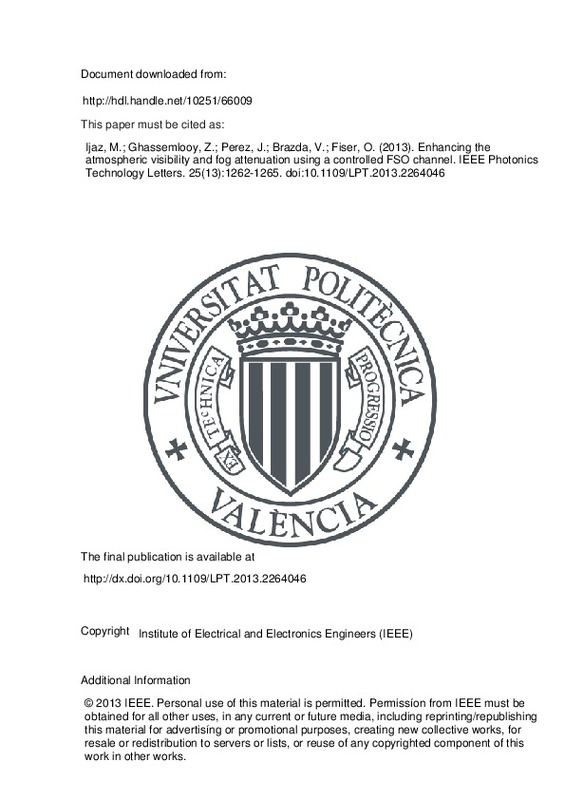JavaScript is disabled for your browser. Some features of this site may not work without it.
Buscar en RiuNet
Listar
Mi cuenta
Estadísticas
Ayuda RiuNet
Admin. UPV
Enhancing the atmospheric visibility and fog attenuation using a controlled FSO channel
Mostrar el registro sencillo del ítem
Ficheros en el ítem
| dc.contributor.author | Ijaz, Muhammad
|
es_ES |
| dc.contributor.author | Ghassemlooy, Zabih
|
es_ES |
| dc.contributor.author | Perez, Joaquin
|
es_ES |
| dc.contributor.author | Brazda, Vladimir
|
es_ES |
| dc.contributor.author | Fiser, Ondrej
|
es_ES |
| dc.date.accessioned | 2016-06-16T08:14:26Z | |
| dc.date.available | 2016-06-16T08:14:26Z | |
| dc.date.issued | 2013-07-01 | |
| dc.identifier.issn | 1041-1135 | |
| dc.identifier.uri | http://hdl.handle.net/10251/66009 | |
| dc.description | © 2013 IEEE. Personal use of this material is permitted. Permissíon from IEEE must be obtained for all other uses, in any current or future media, including reprinting/republishing this material for advertisíng or promotional purposes, creating new collective works, for resale or redistribution to servers or lists, or reuse of any copyrighted component of this work in other works. | |
| dc.description.abstract | [EN] In this letter, two methods for characterizing fog attenuation in terms of atmospheric visibility V in free space optics (FSO) communications are analyzed and compared. Both methods measure the fog attenuation based on V using a charge-coupled device (CCD) camera and a laser-diode at 0.55 μm. The methods are evaluated in a laboratory controlled FSO atmospheric chamber operating at individual wavelengths of 0.83, 1.31, and 1.55 μm using a continuous optical spectrum range 0.6-1.6 μm. The CCD technique shows great accuracy for V <; 50 m and the laser technique for the range 100 m, thus allowing enhancement of the characterization of FSO links in thick and dense fog conditions. The experimental results also show a wavelength dependency for V <; 0.5 km where the attenuation decreases from 52 dB/km at visible wavelengths to 46 dB/km at near infrared wavelengths. | es_ES |
| dc.description.sponsorship | This work was supported in part by European COST actions under Grants IC801 and IC1101, and in part by the grant of the Agency of the Czech Republic GACR P102/11/1376. | |
| dc.language | Inglés | es_ES |
| dc.publisher | Institute of Electrical and Electronics Engineers (IEEE) | es_ES |
| dc.relation.ispartof | IEEE Photonics Technology Letters | es_ES |
| dc.rights | Reserva de todos los derechos | es_ES |
| dc.subject | Free space optics | es_ES |
| dc.subject | Fog attenuation | es_ES |
| dc.subject | Visibility | es_ES |
| dc.subject.classification | TEORIA DE LA SEÑAL Y COMUNICACIONES | es_ES |
| dc.title | Enhancing the atmospheric visibility and fog attenuation using a controlled FSO channel | es_ES |
| dc.type | Artículo | es_ES |
| dc.identifier.doi | 10.1109/LPT.2013.2264046 | |
| dc.relation.projectID | info:eu-repo/grantAgreement/COST//IC1101/EU/Optical Wireless Communications - An Emerging Technology/ | es_ES |
| dc.relation.projectID | info:eu-repo/grantAgreement/GACR//P102%2F11%2F1376/ | es_ES |
| dc.relation.projectID | info:eu-repo/grantAgreement/COST//IC0801/EU/Agreement Technologies/ | es_ES |
| dc.rights.accessRights | Abierto | es_ES |
| dc.contributor.affiliation | Universitat Politècnica de València. Instituto Universitario de Telecomunicación y Aplicaciones Multimedia - Institut Universitari de Telecomunicacions i Aplicacions Multimèdia | es_ES |
| dc.description.bibliographicCitation | Ijaz, M.; Ghassemlooy, Z.; Perez, J.; Brazda, V.; Fiser, O. (2013). Enhancing the atmospheric visibility and fog attenuation using a controlled FSO channel. IEEE Photonics Technology Letters. 25(13):1262-1265. https://doi.org/10.1109/LPT.2013.2264046 | es_ES |
| dc.description.accrualMethod | S | es_ES |
| dc.relation.publisherversion | http://dx.doi.org/10.1109/LPT.2013.2264046 | es_ES |
| dc.description.upvformatpinicio | 1262 | es_ES |
| dc.description.upvformatpfin | 1265 | es_ES |
| dc.type.version | info:eu-repo/semantics/publishedVersion | es_ES |
| dc.description.volume | 25 | es_ES |
| dc.description.issue | 13 | es_ES |
| dc.relation.senia | 254835 | es_ES |
| dc.contributor.funder | European Commission | |
| dc.contributor.funder | European Cooperation in Science and Technology | es_ES |
| dc.contributor.funder | Czech Science Foundation |







![[Cerrado]](/themes/UPV/images/candado.png)

